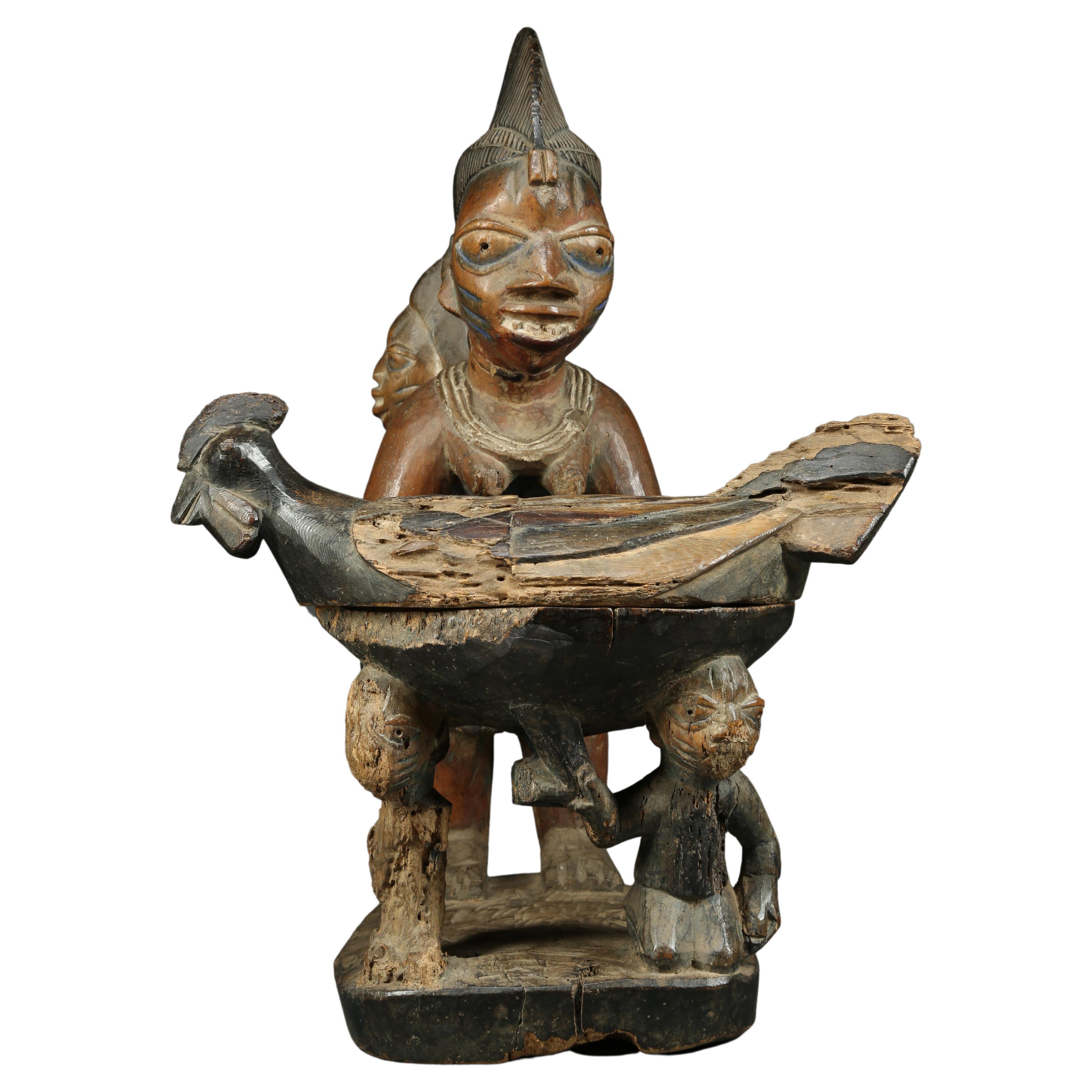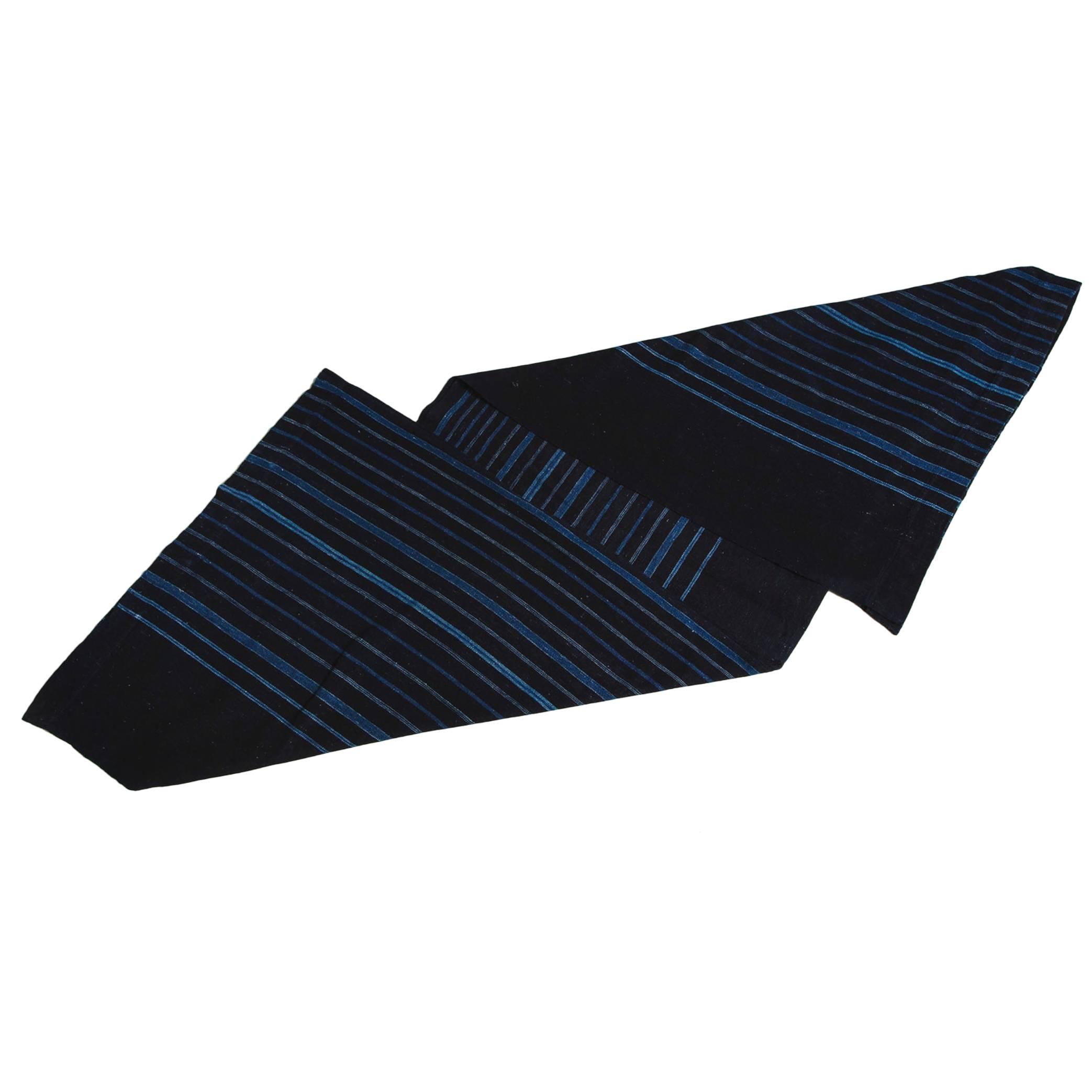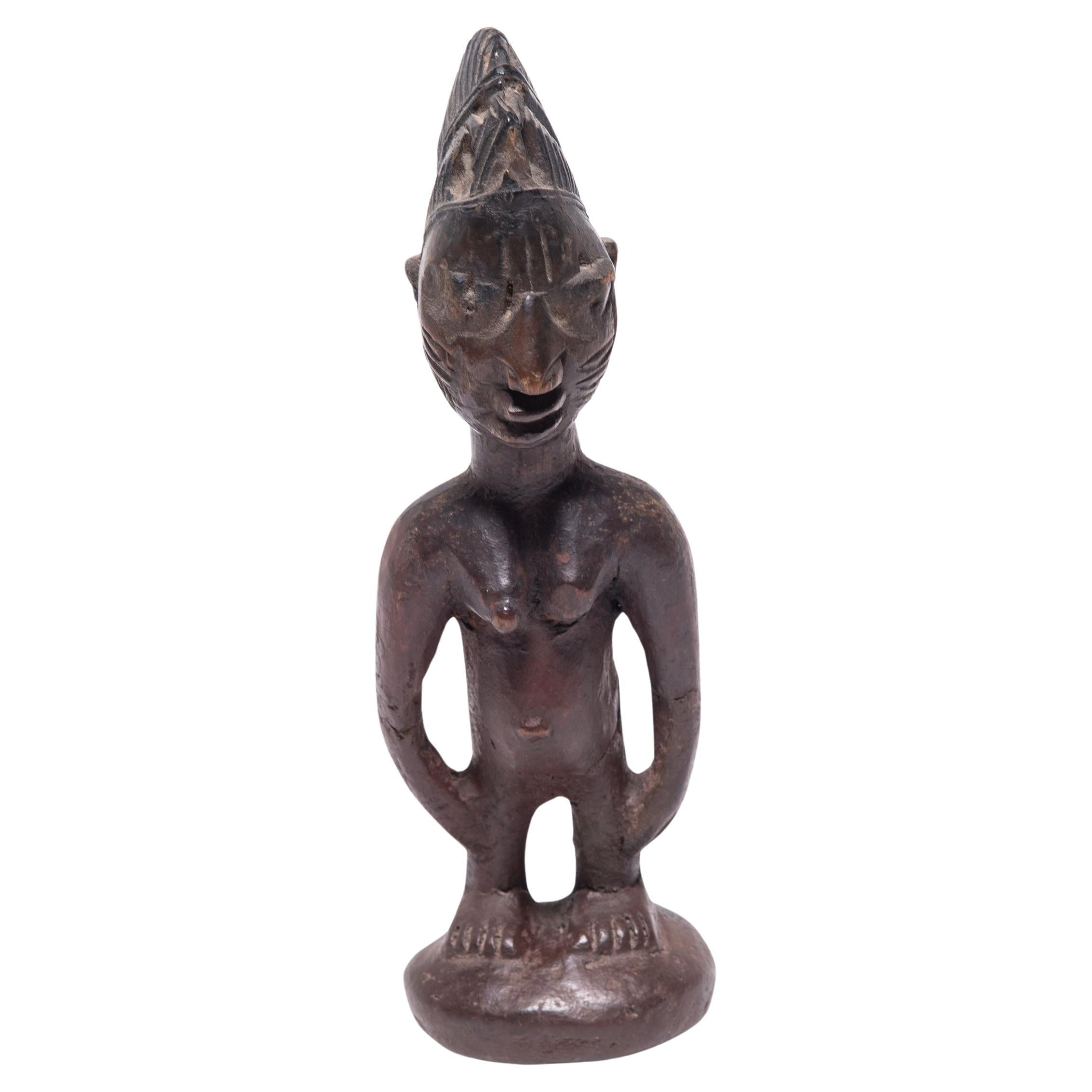Want more images or videos?
Request additional images or videos from the seller
1 of 10
Yoruba Maternity Group
About the Item
Yoruba Maternity Group
Wood, polychrome, pigment, scorching
Old collection name to base: ‘Sealy’ and ‘16.’
Nigeria
Late 19th Century
SIZE: 58cm high - 22¾ ins high
PROVENANCE:
Ex Ernest Ohly collection
Ex Berkeley Gallery, London
Purchased from G Block, 1960’s
Ex London Art Market
Ex Private collection
The Yoruba live predominantly in south western Nigeria and have for centuries been the most prolific art-producing people of Black Africa. The culture of Yoruba, with its complex religious, political and social systems inherited from ancient city-states, evoked the creation of a rich variety of royal and religious sculpture. The Yoruba developed a unique style through which to interpret the rituals and precepts, passions and beliefs of their lives. However, it is the actual community and family in the here and now that form the pivot of Yoruba life. There exists no desire to work toward a better life in the hereafter. While they do hope to join their ancestors when they die, these ancestors are conceived as living a formless existence that is nevertheless focused on the surviving family members in which they hope to be reborn. The ancestors do return to the community, but not through personal reincarnation. Their life force reverts to the community in the form of one or more children.
To the Yoruba the prime manifestation of the life force is fertility and women are the stronger sex as the life force manifests itself directly in them in the form of menstruation and childbirth. This shrine figure may have functioned as a water deity, being placed into a large dish during ceremonies in honour of the river goddess ‘Yemoja’ and carried around by a priestess in a trance. Yemoja is revered as a deity for bestowing the gift of children.
- Dimensions:Height: 22.75 in (57.79 cm)Width: 9 in (22.86 cm)Depth: 11 in (27.94 cm)
- Materials and Techniques:
- Place of Origin:
- Period:
- Date of Manufacture:Late 19th Century
- Condition:Wear consistent with age and use.
- Seller Location:London, GB
- Reference Number:1stDibs: LU9363237206762
About the Seller
No Reviews Yet
Vetted Seller
These experienced sellers undergo a comprehensive evaluation by our team of in-house experts.
Established in 1989
1stDibs seller since 2023
- ShippingRetrieving quote...Ships From: London, United Kingdom
- Return PolicyA return for this item may be initiated within 14 days of delivery.
More From This SellerView All
- A Rare and Exceptional Carved Headrest ‘Kali Hahapo’Located in London, GBA Rare and Exceptional Carved Headrest ‘Kali Hahapo’ Excellent colour and patina Wood, sennet (coconut fibre), glass beads Tonga Late 18th / Early 19th Century SIZE: 19cm high, 5...Category
Antique Early 19th Century Tongan Tribal Art
MaterialsNatural Fiber, Glass, Wood, Coconut
- A Rare and Historically Important Artefact Recovered from HMS Adventure in 1775Located in London, GBA Rare and Historically Important Artefact Recovered from HMS Adventure in 1775 after Captain James Cook’s Second Voyage to the Pacific A ‘coconut husker’ made by a ship’s carpenter aboard HMS Adventure in the style and design of a Native Islander’s ethnographical ‘coconut husker’ An engraved and inscribed copper plaque: A memento from The Sandwich Islands Coconut Husker used aboard HMS Adventure and recovered from The Royal Dockyard Deptford 1775 Oak, iron, brass, copper, handmade iron screws Fine rich colour and patina England / Sandwich Island 18th Century SIZE: 15.5cm high, 49.5cm long, 20cm wide (max) - 6¹⁄₈ ins high, 19½ ins long, 7⁷⁄₈ ins wide (max) Provenance: Found in a Scottish attic after centuries of lying hidden in a crate Ex Private Scottish collection Captain James Cook’s second voyage aboard the Resolution and accompanied by HMS Adventure set sail in July 1772. The discovery of the southern eight islands of the Sandwich Islands group was in 1775. The given name was chosen in honour of John Montagu, 4th Earl of Sandwich, First Lord of the Admiralty. The copper plaque and inscription however should not be read as The Sandwich Islands ‘Owhyhee’ (The Hawaiian Islands) which were later discovered on January 18th, 1778, on Captain Cook’s third voyage. Rather the inscription refers to ‘South Sandwich Islands’ lying to the south east of South Georgia and only renamed later with the word ‘South’ to distinguish them from the ‘Sandwich Islands’ now known as the Hawaiian Islands. Not withstanding during Cook’s second voyage he visited Easter Island, Tahiti, Society Islands, Niue, Tonga, New Hebrides, New Caledonia, Norfolk Islands, Palmerston Island and South Georgia. The crew onboard having been exposed to various types of ‘coconut huskers’ adapted those designs into the example we now see, having been rescued from HMS Adventure in 1775. A rare example of 18th century cross...Category
Antique 16th Century American Tribal Art
MaterialsBrass, Copper, Iron
- A Rare and Finely Carved Egyptian Wooden HeadrestLocated in London, GBA Rare and Finely Carved Egyptian Wooden Headrest with a Carved Head to both Sides Representing the God ‘Bes’ (Protector of the Homestead) above Carved...Category
Antique 15th Century and Earlier Egyptian Tribal Art
MaterialsWood
- A Rare Wood Ear OrnamentLocated in London, GBA Rare Wood Ear Ornament With old collectors label ‘Ear Wood. Paraquay’ Wood Paraguay 19th Century Size: 6cm dia., 3.5cm deep - 2¼ ins dia., 1¼ ins deep Published: Steven Phe...Category
Antique 19th Century Paraguayan Tribal Art
MaterialsWood
- A Finely Carved ‘Boni’ Neck-RestLocated in London, GBA Finely Carved ‘Boni’ Neck-Rest Superb dark colour and patination through extended use Wood Somalia 19th Century SIZE: 18.5cm high, 15.5cm wide - 7¼ ins high, 6 ins wide These hea...Category
Antique 19th Century Tribal Art
MaterialsWood
- A Rare Spirit Mask ‘Barak’ or ‘Yamburai Parak’Located in London, GBA Rare Spirit Mask ‘Barak’ or ‘Yamburai Parak’ Wood, remains of polychrome Eastern Sepik Province, New Guinea Late 19th - early 20th Century SIZE: 45cm high, 35cm deep - 17¾ ins high, 13¾ ins deep Originally these masks were brightly coloured. However, after many years of exposure within the ceremonial houses the colour faded away through use and weathering. The mask was traditionally worn by a dancer whose plant fibre costume completely covered him, and was associated with an important male mythical being. The Barak (sometimes spelled ‘barag’ or ‘brag’) were situated to the west of the Sepik River. The Sepik River was first explored in 1885 by Otto Fisch. He wrote of the regions cultural diversity and beauty of the villages that he saw on the banks of the river over which towered the ‘men’s houses’. In the early 20th century collectors of primitive art were astounded at the sheer quantity of marvellous objects to be found in this region and the extraordinary inventiveness of the forms in this difficult swampy terrain. Provenance: Ex UK Art Market Ex Private collection CF ‘New Guinea Art...Category
Antique Late 19th Century Papua New Guinean Tribal Art
MaterialsWood
You May Also Like
- Yoruba Tribal Maternity Offering Bowl Figure Chicken, Nigeria Africa weatheredLocated in Point Richmond, CABlessed by time, an early beautiful Yoruba female figure with baby riding on back, presenting an offering bowl in the form of a chicken with a removable top. Great Yoruba mother's face with scarifications and an excited baby. Areas of heavy wear, erosion and insect damage, especially to the two figures supporting the bowl, top of the chicken bowl...Category
Early 20th Century Nigerian Tribal Tribal Art
MaterialsWood
- Beaded Yoruba StaffLocated in Chicago, ILThe Yoruba people reserve the use of glass beads for royalty, priests and priestesses, as well as embellishing ritual and ceremonial objects. Though only kings are allowed to use bea...Category
Mid-20th Century South African Folk Art Tribal Art
MaterialsMetal, Iron
- Yoruba Indigo ClothLocated in Greenwich, CTHand dyed Yoruba (Nigeria) cloth from the Esie area, 1950s.Category
Vintage 1950s Nigerian Tribal Art
MaterialsCotton
- Yoruba Ibeji pairLocated in London, GBIbeji pair Ajasse Nigeria Wood, beads, pigment, offering remains 26.5cm and 25cm ex Beatrice Leutert and Marcel Plüss collection, Thurgau, SwitzerlandCategory
Early 20th Century Tribal Art
MaterialsWood
- Yoruba Ibeji Twin FigureBy Yoruba PeopleLocated in Chicago, ILWith one of the highest rates of twin births in the world, Yoruba cultures place special social and religious significance on twins, referred to as "emi alagbara" or "powerful spirit...Category
Mid-20th Century Nigerian Tribal Tribal Art
MaterialsWood
- Yoruba Omo Bell, c. 1900Located in Chicago, ILThis four-sided brass face bell, known as omo, was created by an artisan of the Ijebu Yoruba People of Southern Nigeria. A mark of the wearer's rank and power, the bell would have be...Category
Early 20th Century Nigerian Tribal Mounted Objects
MaterialsMetal
Recently Viewed
View AllMore Ways To Browse
Tribal Fertility
Fertility Form
Sex Furniture
Antique Furniture South Africa
South African Antique Furniture
River Of No Return
Antique Furniture In South Africa
African Antiques
African Life Size
Berkeley Used Furniture
Revert Furniture
African Wood Block
Goddess Dior
Antique African Wood Sculptures
Religious Shrine
Folk Art 1960s Wood Sculpture
Ancestor Figure
Antique Childrens Blocks





